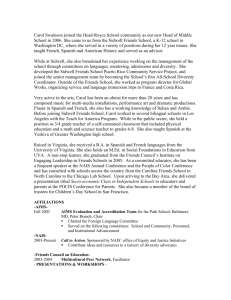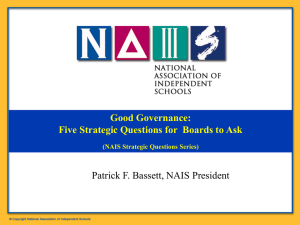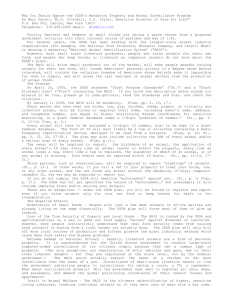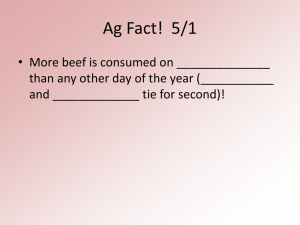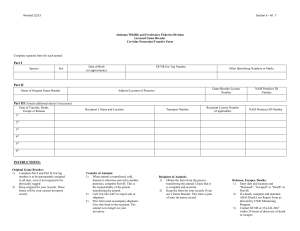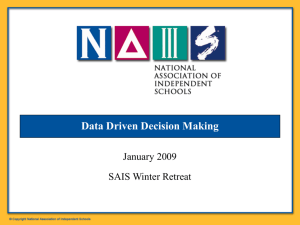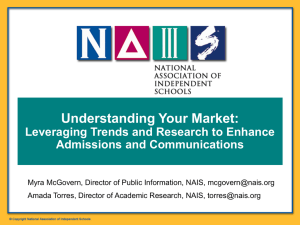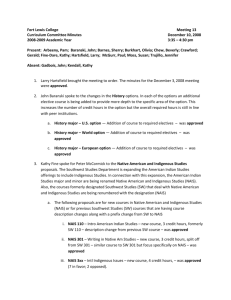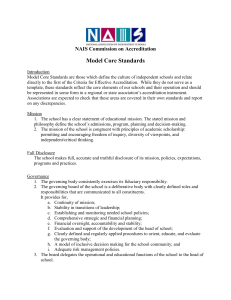The National Animal Identification System (NAIS) and Horses
advertisement
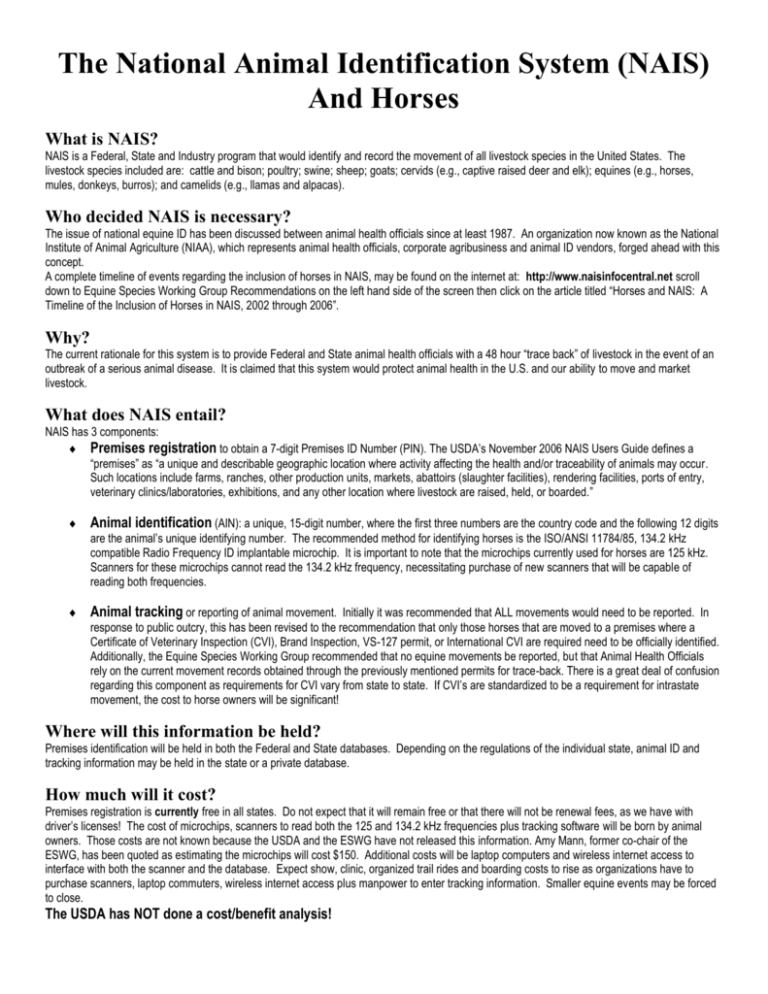
The National Animal Identification System (NAIS) And Horses What is NAIS? NAIS is a Federal, State and Industry program that would identify and record the movement of all livestock species in the United States. The livestock species included are: cattle and bison; poultry; swine; sheep; goats; cervids (e.g., captive raised deer and elk); equines (e.g., horses, mules, donkeys, burros); and camelids (e.g., llamas and alpacas). Who decided NAIS is necessary? The issue of national equine ID has been discussed between animal health officials since at least 1987. An organization now known as the National Institute of Animal Agriculture (NIAA), which represents animal health officials, corporate agribusiness and animal ID vendors, forged ahead with this concept. A complete timeline of events regarding the inclusion of horses in NAIS, may be found on the internet at: http://www.naisinfocentral.net scroll down to Equine Species Working Group Recommendations on the left hand side of the screen then click on the article titled “Horses and NAIS: A Timeline of the Inclusion of Horses in NAIS, 2002 through 2006”. Why? The current rationale for this system is to provide Federal and State animal health officials with a 48 hour “trace back” of livestock in the event of an outbreak of a serious animal disease. It is claimed that this system would protect animal health in the U.S. and our ability to move and market livestock. What does NAIS entail? NAIS has 3 components: Premises registration to obtain a 7-digit Premises ID Number (PIN). The USDA’s November 2006 NAIS Users Guide defines a “premises” as “a unique and describable geographic location where activity affecting the health and/or traceability of animals may occur. Such locations include farms, ranches, other production units, markets, abattoirs (slaughter facilities), rendering facilities, ports of entry, veterinary clinics/laboratories, exhibitions, and any other location where livestock are raised, held, or boarded.” Animal identification (AIN): a unique, 15-digit number, where the first three numbers are the country code and the following 12 digits are the animal’s unique identifying number. The recommended method for identifying horses is the ISO/ANSI 11784/85, 134.2 kHz compatible Radio Frequency ID implantable microchip. It is important to note that the microchips currently used for horses are 125 kHz. Scanners for these microchips cannot read the 134.2 kHz frequency, necessitating purchase of new scanners that will be capable of reading both frequencies. Animal tracking or reporting of animal movement. Initially it was recommended that ALL movements would need to be reported. In response to public outcry, this has been revised to the recommendation that only those horses that are moved to a premises where a Certificate of Veterinary Inspection (CVI), Brand Inspection, VS-127 permit, or International CVI are required need to be officially identified. Additionally, the Equine Species Working Group recommended that no equine movements be reported, but that Animal Health Officials rely on the current movement records obtained through the previously mentioned permits for trace-back. There is a great deal of confusion regarding this component as requirements for CVI vary from state to state. If CVI’s are standardized to be a requirement for intrastate movement, the cost to horse owners will be significant! Where will this information be held? Premises identification will be held in both the Federal and State databases. Depending on the regulations of the individual state, animal ID and tracking information may be held in the state or a private database. How much will it cost? Premises registration is currently free in all states. Do not expect that it will remain free or that there will not be renewal fees, as we have with driver’s licenses! The cost of microchips, scanners to read both the 125 and 134.2 kHz frequencies plus tracking software will be born by animal owners. Those costs are not known because the USDA and the ESWG have not released this information. Amy Mann, former co-chair of the ESWG, has been quoted as estimating the microchips will cost $150. Additional costs will be laptop computers and wireless internet access to interface with both the scanner and the database. Expect show, clinic, organized trail rides and boarding costs to rise as organizations have to purchase scanners, laptop commuters, wireless internet access plus manpower to enter tracking information. Smaller equine events may be forced to close. The USDA has NOT done a cost/benefit analysis! When will this system be implemented? Initially the USDA called for the NAIS to become mandatory in 2009. Again, in response to public outcry, the USDA published a revision of their plan on November 22, 2006 stating the NAIS would be “voluntary at the Federal Level”. Why should horse owners be concerned if the system is voluntary? The key words are “voluntary at the Federal Level”. This is nothing more than a smokescreen. While the USDA is touting the “voluntary” status widely in the media, behind the scenes it is providing monetary incentives to the individual states and Native American tribes via grants through Cooperative Agreements. What they neglect to mention is that some states are registering premises WITHOUT the owners knowledge and consent using existing disease databases (e.g.: Coggins) to meet the goals set forth in Cooperative Agreements. Wisconsin made NAIS mandatory for all livestock species, including horses, on January 1, 2006. Michigan recently made NAIS mandatory for all cattle. Several other states have legislation pending to implement various forms of a mandatory NAIS while 11 states have proposed legislation to prohibit NAIS. Congressman Colin Peterson (D-MN), the current Chairman of the House Agricultural Committee, has long supported a mandatory NAIS. Minnesota's Sauk Centre Herald reported that Peterson finds the USDA's current approach to a voluntary NAIS "screwed up" and Peterson "strongly believes the government needs to set the rules and require standardization." Minnesota based Digital Angel, manufacturers of a radio frequency ID (RFID) animal tracking device approved by the USDA for NAIS, stands to reap a windfall from NAIS. USDA Deputy Secretary Chuck Conner testified at the March 13, 2007 Hearing of the House Appropriations subcommittee on Agriculture that the USDA has spent $118 million since fiscal 2004 on livestock ID. Conner told the hearing that so far 350,000 livestock premises, or about 25 percent of the total, have been registered. The USDA claims they have the authority to implement a mandatory NAIS under the Animal Health Protection Act (US Code of Federal Regulations Title 7, Chapter 109, § 8315: Regulations and orders). The USDA's authority and funding for NAIS will be hot topics for both the Agriculture and Appropriations Committees of this Congress. Horse owners need to get involved and watch the situation closely both on a federal and state level, otherwise this expensive and intrusive system will be forced upon us before we know it. Take Action: Contact the members of the House Committee on Agriculture. Their website is: http://agriculture.house.gov/index.shtml Their contact info may be found on the internet at: http://www.house.gov/house/MemberWWW.shtml Contact the members of the Senate Agriculture Committee. Their website is: http://agriculture.senate.gov/ Their contact info may be found on the internet at: http://www.senate.gov/general/contact_information/senators_cfm.cfm Contact the members of the House Appropriations subcommittee on Agriculture and urge them to defund NAIS! The members are: Chair: Rosa DeLauro (D-CT), Ranking Member: Jack Kingston (R-GA), Maurice D. Hinchey (D-NY), Sam Farr (D-CA), Allen Boyd (D-FL), Sanford Bishop (D-GA), Marcy Kaptur (D-OH), Jesse L. Jackson, Jr. (D-IL), Steven R. Rothman (D-NJ), Dave Obey (D-WI), Tom Latham (R-IA), Jo Ann Emerson (R-MO), Ray LaHood (R-IL), Rodney Alexander (R-LA), Jerry Lewis (R-CA) Their contact info may be found on the internet at: http://www.house.gov/house/MemberWWW.shtml Contact the federal and state legislators for your district. Their contact info may be found at: http://www.congress.org/ Enter your zip code in the box under “Write Your Officials” and click on the arrow (►). E-mail the Equine Species Working Group with your concerns: info@equinespeciesworkinggroup.com or fax them to: 202-296-1970. Submit your comments and concerns to the USDA using their on-line form: http://animalid.aphis.usda.gov/nais/contact_us/general.shtml. Unfortunately, despite their claims that they want our feedback, the USDA has chosen NOT to reveal a mailing address or fax number. Pass this flier on to other horse owners! Find more information about NAIS: LibertyArk Coalition: http://www.libertyark.org/ Farm and Ranch Freedom Alliance: http://farmandranchfreedom.org/ NAIS Info Central: http://www.naisinfocentral.net
